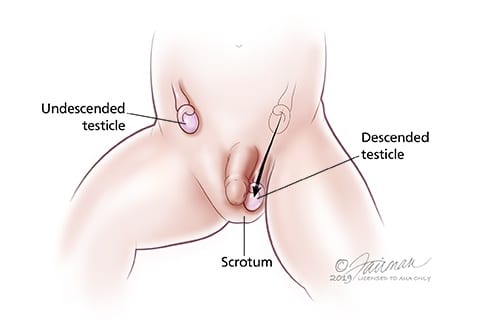General description of the disease
Cryptorchidism is an anomaly of a congenital nature in which a boy, during a postpartum examination, reveals that one or two testicles are missing from the scrotum. This is due to its delay or their lowering to the bottom of the scrotum from the peritoneal space along the inguinal canal.
The causes of this anomaly:
- the boy is a premature baby (according to medical observations, cryptorchidism is observed in 8-20% of premature babies, and in full-term babies this is only 4%);
- small baby weight (less than two and a half kilograms);
- disturbances in the work of the endocrine system and the work of the pituitary gland of a pregnant woman (the presence of goiter, diabetes mellitus) or the intake of estrogens fell in the first trimester of pregnancy;
- hormonal disruption in the embryo;
- the woman had a multiple pregnancy;
- the baby’s inguinal canal is too narrow;
- shortened spermatic cord or testicular vessels;
- underdeveloped ligamentous apparatus of the testicles;
- various adhesions inside the peritoneum;
- Down syndrome;
- mutated GTH gene;
- an inguinal hernia in a baby;
- defects in the development of the anterior abdominal wall occurred in the womb.
Classification of cryptorchidism
Depending on the number of undescended testicles, cryptorchidism can be:
- one-sided (one testicle did not descend);
- bilateral (2 testicles did not get to the bottom of the scrotum).
Depending on the time of appearance:
- congenital – the child has already been born with an undescended testicle (s);
- secondary – in the boy, the anomaly develops after birth (the dropped testicles or the testicle rise up the groin canal and no longer descend) due to the fact that the muscle that lifted them fixes in such a raised position, in addition, such an elevation is possible due to adhesions in a facies pocket.
Depending on whether the testicle was in the scrotum or not, cryptorchidism is:
- false – the testicle was at the bottom of the scrotum, but rose up;
- true – the testicle on the way to the scrotum collapsed and there was no prolapse.
Possible locations of the testicles (testicles):
- 1 abdominal cavity;
- 2 upper thigh;
- 3 crotch;
- 4 inguinal canal and its superficial pocket;
- 5 outer ring;
- 6 any place on the way to the scrotum.
Symptoms of cryptorchidism:
- the main symptom is the absence of a testicle (s) in the scrotum, which is checked during examination using the palpation method;
- secondary signs are considered to be aching pain in the groin area, in the thigh area, painful sensations when going to the toilet in large quantities, when performing physical activity; abdominal pain disturbs those who have a testicle in the abdominal cavity.
If the medical measures are not taken in time, then the boy may have serious complications in the form of testicular degeneration, infertility or the occurrence of a testicular cancer. This is because if it is in the abdominal cavity or elsewhere, it overheats (the temperature in the scrotum is several degrees lower). Exposure to elevated temperatures negatively affects the quality and quantity of sperm produced. If overheating is constant, then there is a huge risk that fertility may disappear altogether.
Useful products for cryptorchidism
Basically, insufficient testosterone is believed to be the cause of undescended testes in males, so eating foods that will increase testosterone levels to help push them into the scrotum. To do this, you should eat:
- 1 all seafood;
- 2 nuts: walnuts, hazelnuts, pistachios;
- 3 vegetables: cabbage, zucchini, blue, celery, tomatoes, carrots, red peppers;
- 4 fruits and berries: avocados, oranges, papaya, persimmons, pears, peaches, apricots, melons, grapes, currants, cranberries, cherries, raspberries, plums, watermelons, pomegranates;
- 5 herbs and spices: mustard, parsley, onion, cilantro, spinach, turmeric, cardamom, garlic;
- 6 porridge: barley, buckwheat, rice, wheat;
- 7 dried fruits: dried apricots, dates, raisins, prunes.
Traditional medicine for cryptorchidism
Traditional healers recommend taking warm relaxing baths with herbs and oils (they will help widen the inguinal canal or relax the muscle that has pinched the testicles).
Also, you should drink decoctions from ginseng root, golden root, eleutherococcus, lemongrass.
In the treatment of cryptorchidism, 2 treatment options are provided: conservative and surgical. Conservative treatment includes massage treatments and hormone administration. If these procedures did not help, then an operation is prescribed.
Treatment with folk remedies, with this anomaly, is only auxiliary in nature.
With congenital cryptorchidism, the operation is prescribed for 1,5-2 years. They wait just that long, because in most cases (in the absence of a hernia and other anomalies), the testicles themselves take the desired position. With secondary cryptorchidism, the operation can be performed at a much older age.
In the presence of adhesions, twisting of the seminal canal, hernia, the operation is prescribed before the age of one year.
Dangerous and harmful products for cryptorchidism
- overly salty, sweet food;
- carbonated and alcoholic drinks;
- caffeine;
- fatty meats and meat grown on hormones (a female hormone is administered to animals for weight gain);
- a large amount of soybeans and legumes, vegetable fats, fatty milk, bird eggs;
- fast food and fast food;
- smoked products;
- white bread made with yeast dough;
- store sauces, mayonnaises, seasonings.
All of these foods lower testosterone levels, which can negatively affect men’s health and strength. Also, you should stop smoking (tobacco constricts blood vessels, which disrupts the blood supply to the genitals).
Attention!
The administration is not responsible for any attempt to use the information provided, and does not guarantee that it will not harm you personally. The materials cannot be used to prescribe treatment and make a diagnosis. Always consult your specialist doctor!










